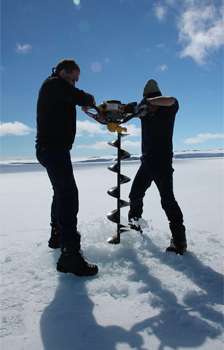Shift in westerly winds leading to climate impacts is human-induced

A shortage of data on the weather in Antarctica is hampering efforts to understand climate change in the region, according to new research.
The study, led by Dr Julie Jones from the University of Sheffield's Department of Geography, has revealed that limited data on Antarctica's climate is making it difficult for researchers to disentangle changes caused by human activity from natural climate fluctuations.
Scientists can confidently say that the Earth is warming due to greenhouse gas emissions caused by humans, but data on climate trends over the Antarctic and the surrounding Southern Ocean only go back to 1979 when regular satellite observations began. This makes it difficult for researchers to see how longer term climate trends have changed in the region.
The inhospitable nature of the continent means that it has never had permanent inhabitants to take regular weather observations unlike most other places on the planet.
The first routine observations only started in 1957 with the establishment of the network of Antarctic Research Stations. This provides important weather data, however they are mostly located around the coast, so leave vast areas of the continent and the surrounding oceans uncovered.
It is only with the advent of regular satellite observations in 1979 that measurement of surface climate over the Antarctic and the surrounding Southern Ocean became possible.
To gain a longer view of recent changes, Dr Jones and her international team of scientists used a compilation of climate records from natural archives, such as ice cores from the Antarctic ice sheet, which give indications of how the region's climate has changed over the last 200 years. They also studied how these recent changes compared to those in experiments with climate models.
They confirmed that human-induced changes have caused the belt of prevailing westerly winds over the Southern Ocean to shift towards Antarctica.
The research concludes that for other changes, such as regional warming and sea ice changes, the observations over the satellite-era since 1979 are not yet long enough for the signal of human-induced climate change to be clearly separated from the strong natural variability in the region
Understanding Antarctic climate change is important not only because of the potential sea level rise locked up in the vast Antarctic ice sheet, but also the shift in the westerly winds has moved rainfall away from southern Australia. In combination with increasing temperatures (this year is set to be the country's hottest year on record) this has had profound impacts on Australian communities and ecosystems
Dr Julie Jones said: "The Antarctic climate is like a giant jigsaw puzzle with most of the pieces still missing. There are some parts of the picture which are clear, particularly the way that climate change is causing westerly winds to shift southwards, but there are still huge gaps that we need to fill in order to fully understand how much human activity is changing weather in the region.
"At face-value, many of the climate trends in Antarctica seem counter-intuitive for the warming world. Scientists have good theories for why, but these are difficult to prove with the short records we are working with."
Co-author Nerilie Abram, from the Australian National University, said: "In order to better understand climate change in Antarctica, we need continued climate measurements in the Antarctic and Southern Ocean, and extension of these short observational records with past climate reconstructions and climate modelling."
Co-researcher Professor Matthew England from the University of New South Wales added that scientists still had much to learn about the climate system of Antarctica and the region, and how it would affect people and the environment.
The Sheffield-led research team included scientists from 19 institutions from around the world. Their results will help to shape the way the University contributes to the global effort of understanding climate change and gives geography students at Sheffield access to the latest innovations in climate change research.
More information: Julie M. Jones et al. Assessing recent trends in high-latitude Southern Hemisphere surface climate, Nature Climate Change (2016). DOI: 10.1038/nclimate3103
Journal information: Nature Climate Change
Provided by University of Sheffield




















